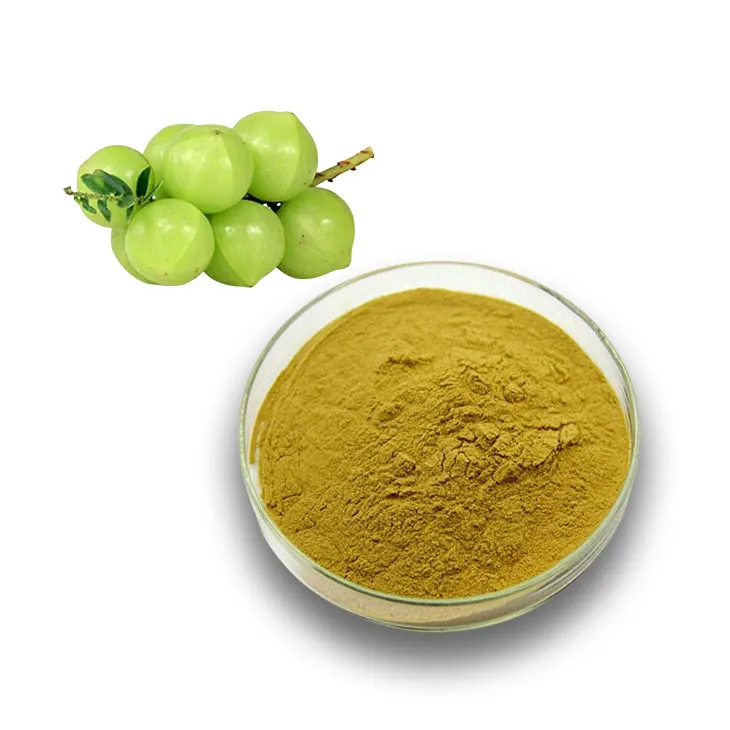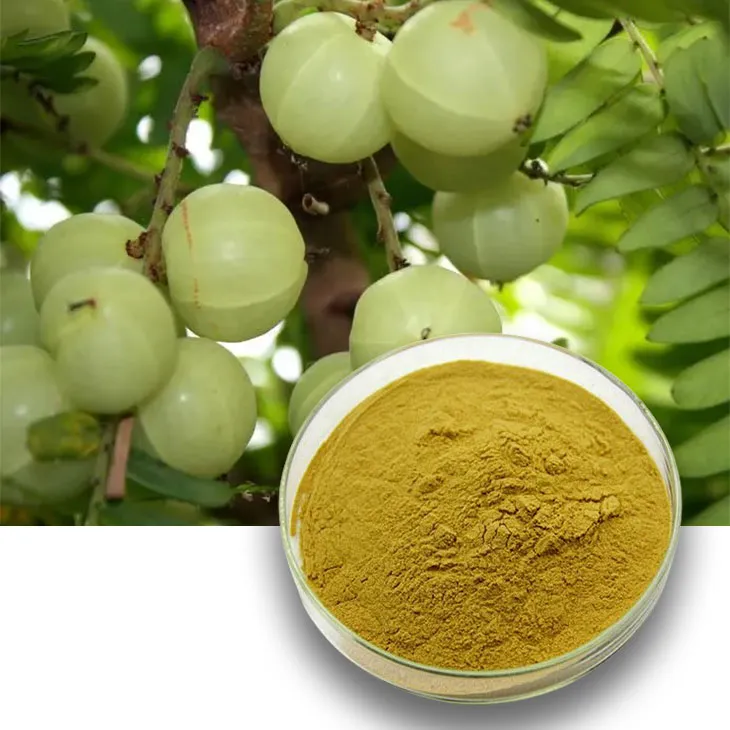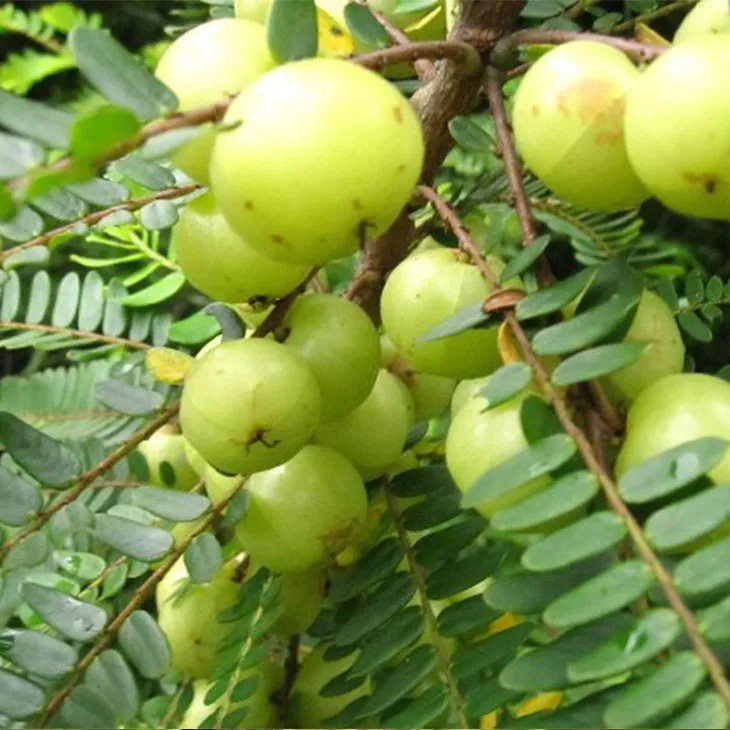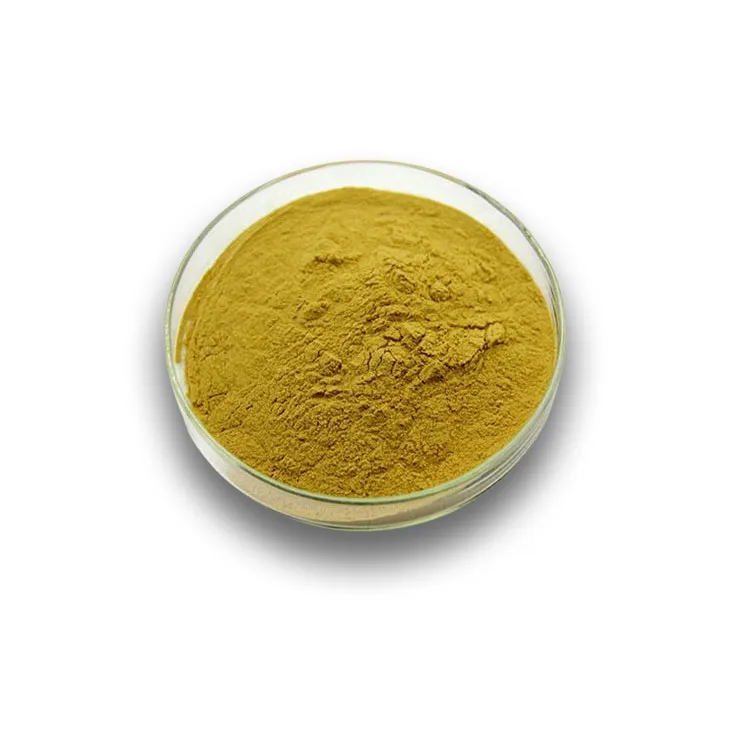- 0086-571-85302990
- sales@greenskybio.com
The process of extracting ellagic acid from Phyllanthus emblica extract.
2024-11-29

1. Introduction
Phyllanthus emblica, also known as Indian gooseberry, has been used in traditional medicine systems for centuries. It is rich in a variety of bioactive compounds, and ellagic acid is one of the most significant ones. Ellagic acid has attracted considerable attention due to its potential applications in the fields of health, cosmetics, and food industries. The extraction of ellagic acid from Phyllanthus Emblica Extract is a complex but interesting process that involves multiple steps and considerations.

2. Chemical Composition of Phyllanthus emblica
Before delving into the extraction process, it is crucial to understand the chemical composition of Phyllanthus emblica. It contains a wide range of compounds such as tannins, flavonoids, phenolic acids, and vitamins. Tannins are a major component, and ellagic acid is often found in the form of ellagitannins in the plant. These ellagitannins can be hydrolyzed to release ellagic acid during the extraction process.

3. Initial Treatment of Phyllanthus Emblica Extract
3.1 Collection and Preparation
The first step in obtaining ellagic acid from Phyllanthus emblica is the proper collection of the plant material. The fruits are usually harvested at the appropriate maturity stage. After collection, they need to be thoroughly washed to remove any dirt, debris, or pesticides. Then, the fruits are dried either under the sun or in a drying oven at a controlled temperature. Drying helps in reducing the moisture content, which is essential for the subsequent extraction steps.
3.2 Grinding
Once the fruits are dried, they are ground into a fine powder. This increases the surface area of the plant material, which in turn enhances the efficiency of the extraction process. The grinding should be done to a consistent particle size to ensure uniform extraction. A mortar and pestle or a mechanical grinder can be used for this purpose.

4. Extraction Methods
4.1 Solvent Extraction
- Solvent Selection: One of the most common methods for extracting ellagic acid from Phyllanthus emblica is solvent extraction. The choice of solvent is crucial. Ethanol, methanol, and acetone are some of the solvents that have been used effectively. Ethanol is often preferred due to its relatively low toxicity and availability. For example, a certain proportion of ethanol - water mixture can be used as the extraction solvent.
- Extraction Process: The ground Phyllanthus emblica powder is mixed with the selected solvent in a suitable container. The ratio of powder to solvent is an important factor that can affect the extraction yield. It is usually recommended to use a ratio such as 1:10 (powder: solvent by weight). The mixture is then stirred continuously for a specific period, usually several hours. This can be done at room temperature or with mild heating to increase the solubility of ellagic acid in the solvent.
- Filtration: After the extraction period, the mixture is filtered to separate the liquid extract (containing ellagic acid) from the solid residue. A filter paper or a Buchner funnel can be used for this filtration step. The filtrate obtained is then ready for further purification.
4.2 Supercritical Fluid Extraction
- Supercritical fluid extraction (SFE) is another advanced method for extracting ellagic acid. In this method, carbon dioxide (CO₂) is often used as the supercritical fluid. CO₂ in its supercritical state has unique properties such as high diffusivity and low viscosity, which make it an excellent solvent for extracting bioactive compounds.
- The Phyllanthus emblica powder is placed in an extraction vessel, and supercritical CO₂ is passed through it. The pressure and temperature conditions are carefully controlled to maintain the supercritical state of CO₂. By adjusting these parameters, the selectivity and efficiency of the extraction can be optimized.
- One advantage of SFE over solvent extraction is that it is a more environmentally friendly method as it does not leave behind any organic solvent residues. However, the equipment required for SFE is more expensive and complex.

5. Purification of Ellagic Acid
5.1 Column Chromatography
- Column chromatography is a widely used method for purifying ellagic acid from the crude extract. A suitable stationary phase, such as silica gel or a resin, is packed into a column. The crude extract is then loaded onto the top of the column.
- Different solvents or solvent mixtures are used as the mobile phase to elute the components. Ellagic acid, due to its specific chemical properties, will be eluted at a certain point, while other impurities will be separated. For example, a gradient of methanol - water can be used as the mobile phase to achieve better separation.
- The fractions containing ellagic acid are collected and combined for further analysis or use.
5.2 Recrystallization
- Recrystallization is another purification method. The crude ellagic acid obtained from the extraction process is dissolved in a suitable solvent at a high temperature. The choice of solvent depends on the solubility characteristics of ellagic acid. For example, ethanol can be used.
- As the solution cools down slowly, ellagic acid crystals start to form. The impurities remain in the solution, and the pure ellagic acid crystals can be separated by filtration. This method is relatively simple but may require multiple recrystallization steps to achieve a high - purity product.
6. Challenges in the Extraction Process
6.1 Yield Optimization
- One of the major challenges in extracting ellagic acid from Phyllanthus emblica is optimizing the yield. The extraction yield can be affected by various factors such as the extraction method, solvent choice, extraction time, and temperature. For example, if the extraction time is too short, not all of the ellagic acid may be extracted from the plant material. On the other hand, if the extraction time is too long, it may lead to the degradation of ellagic acid or the extraction of unwanted impurities.
- Similarly, the choice of solvent can significantly impact the yield. Some solvents may have a higher affinity for ellagic acid, but they may also extract other compounds along with it, which can make the purification process more difficult.
6.2 Purity and Quality Control
- Ensuring the purity of the extracted ellagic acid is another challenge. The presence of impurities can affect the performance of ellagic acid in various applications. During the purification process, it is essential to develop effective methods to separate ellagic acid from other closely related compounds. This requires careful selection of purification techniques and optimization of the operating conditions.
- Quality control is also crucial. Analytical methods such as high - performance liquid chromatography (HPLC) are often used to determine the purity and quantity of ellagic acid in the final product. However, these methods can be expensive and require specialized equipment and trained personnel.
7. Importance of Ellagic Acid from Phyllanthus emblica
7.1 In the Health Industry
- Ellagic acid has been shown to possess antioxidant properties. It can scavenge free radicals in the body, which are associated with various diseases such as cancer, cardiovascular diseases, and neurodegenerative disorders. By neutralizing free radicals, ellagic acid helps in protecting cells from oxidative damage.
- It also has anti - inflammatory effects. Inflammation is a key factor in many chronic diseases, and ellagic acid can modulate the inflammatory response in the body. This makes it a potential candidate for the development of anti - inflammatory drugs or dietary supplements.
7.2 In the Cosmetics Industry
- The antioxidant properties of ellagic acid are highly valued in the cosmetics industry. It can be added to skin care products such as creams, lotions, and serums to protect the skin from environmental damage such as UV radiation and pollution. By preventing oxidative stress on the skin, ellagic acid can help in reducing the signs of aging, such as wrinkles and fine lines.
- It also has antibacterial and antifungal properties, which can be beneficial for maintaining the health of the skin and hair. For example, it can be used in products for treating acne or dandruff.
7.3 In Other Industries
- In the food industry, ellagic acid can be used as a natural preservative due to its antioxidant and antimicrobial properties. It can help in extending the shelf life of food products while maintaining their nutritional value.
- There is also potential for its use in the pharmaceutical industry for the development of new drugs. Ellagic acid's diverse biological activities make it an interesting compound for further research and drug discovery.
8. Conclusion
The extraction of ellagic acid from Phyllanthus Emblica Extract is a multi - step process that involves initial treatment, extraction, and purification. While there are challenges in optimizing the yield and ensuring purity, the importance of ellagic acid in various industries makes it a valuable compound worthy of further study. Continued research in extraction techniques and purification methods will likely lead to more efficient and cost - effective ways of obtaining high - quality ellagic acid from Phyllanthus emblica in the future.
FAQ:
What are the first steps in the initial treatment of Phyllanthus emblica extract for ellagic acid extraction?
The first steps in the initial treatment may include drying and grinding the Phyllanthus emblica to a fine powder. This helps to increase the surface area, making it more accessible for the subsequent extraction process. Also, it may involve pre - treatment with certain solvents to remove impurities or unwanted components that could interfere with the extraction of ellagic acid.
Which extraction methods are commonly used to extract ellagic acid from Phyllanthus emblica extract?
Common extraction methods include solvent extraction. For example, using organic solvents like ethanol or methanol. Supercritical fluid extraction can also be an option. These solvents can dissolve ellagic acid from the Phyllanthus emblica extract. Another method could be microwave - assisted extraction, which can enhance the extraction efficiency by using microwave energy to break the cell walls and release ellagic acid more effectively.
How is the purification of ellagic acid carried out after extraction?
After extraction, purification can be achieved through various techniques. Chromatographic methods such as column chromatography are often used. In column chromatography, a stationary phase and a mobile phase are used. Ellagic acid will interact differently with the stationary phase compared to other impurities, allowing for its separation. Recrystallization is another method, where the crude ellagic acid extract is dissolved in a suitable solvent and then allowed to recrystallize, leaving behind impurities.
What are the main challenges in extracting ellagic acid from Phyllanthus emblica extract?
One of the main challenges is the presence of interfering substances in the Phyllanthus emblica extract. These substances may have similar chemical properties to ellagic acid, making it difficult to separate them during extraction and purification. Another challenge is achieving high extraction efficiency without degrading ellagic acid. The extraction process needs to be optimized to ensure that a sufficient amount of ellagic acid is obtained while maintaining its chemical integrity. Also, cost - effectiveness is a concern, as some extraction and purification methods can be expensive.
Why is ellagic acid from Phyllanthus emblica important in the health industry?
Ellagic acid from Phyllanthus emblica has antioxidant properties. It can help to neutralize free radicals in the body, which are associated with various diseases such as cancer and heart disease. It may also have anti - inflammatory effects, which can be beneficial for conditions like arthritis. Additionally, it has been studied for its potential in promoting healthy skin, as it can protect the skin from oxidative damage and may have anti - aging effects.
Related literature
- Extraction and Characterization of Ellagic Acid from Phyllanthus emblica: A Review"
- "The Role of Ellagic Acid from Phyllanthus emblica in Cosmetic Applications"
- "Optimizing the Extraction of Ellagic Acid from Phyllanthus emblica for Health - Promoting Products"
- ▶ Hesperidin
- ▶ Citrus Bioflavonoids
- ▶ Plant Extract
- ▶ lycopene
- ▶ Diosmin
- ▶ Grape seed extract
- ▶ Sea buckthorn Juice Powder
- ▶ Fruit Juice Powder
- ▶ Hops Extract
- ▶ Artichoke Extract
- ▶ Mushroom extract
- ▶ Astaxanthin
- ▶ Green Tea Extract
- ▶ Curcumin
- ▶ Horse Chestnut Extract
- ▶ Other Product
- ▶ Boswellia Serrata Extract
- ▶ Resveratrol
- ▶ Marigold Extract
- ▶ Grape Leaf Extract
- ▶ New Product
- ▶ Aminolevulinic acid
- ▶ Cranberry Extract
- ▶ Red Yeast Rice
- ▶ Red Wine Extract
-
Gynostemma pentaphyllum extract
2024-11-29
-
Mulberry Extract
2024-11-29
-
Hawthorn powder
2024-11-29
-
Andrographis Paniculata Extract Powder
2024-11-29
-
White mustard seed extract
2024-11-29
-
Cranberry Extract
2024-11-29
-
Berberis aristata Extract
2024-11-29
-
Stevia Extract
2024-11-29
-
Reishi mushroom extract
2024-11-29
-
Horse Chestnut Extract
2024-11-29





















